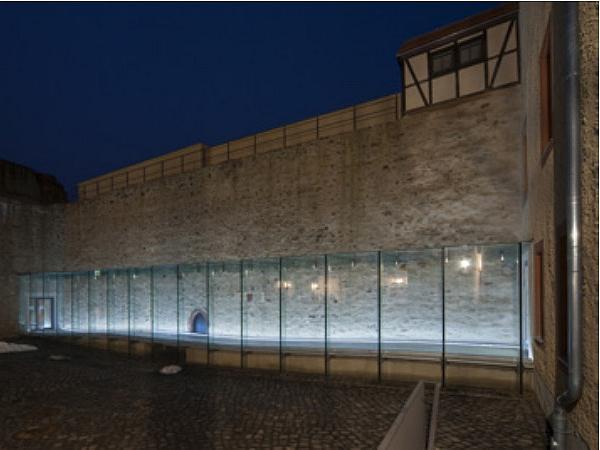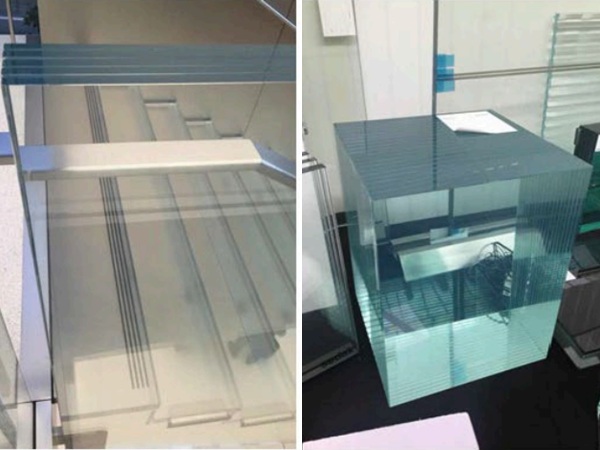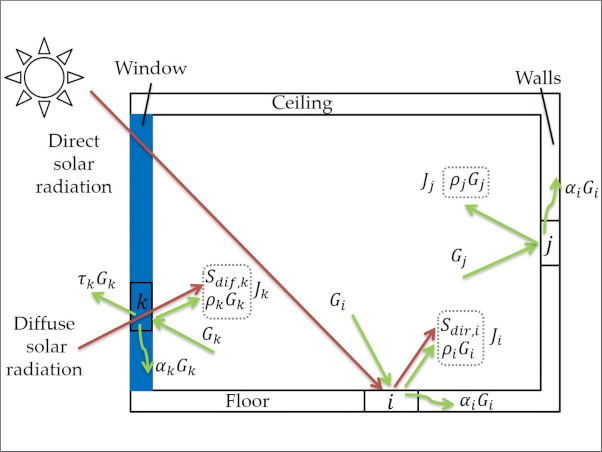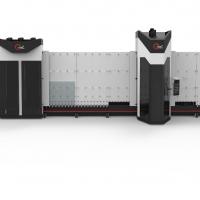First presented at GPD 2019
However, the building industry still has an enormous amount of catching up to do when it comes to load-bearing adhesive joints. The glass and façade sector provides an ideal field of application for adhesive bonding since prefabrication and industrial automation are prevalent in the manufacturing process.
Several companies along the value chain of a bonded glass construction and research institutions have founded the KLEBTECH network to use bonding technology for promising product innovations. In order to be able to strengthen the bonding technology in glass and façade construction, the network combines individual know-how, exploits synergy effects and masters the complex challenges of adhesive bonding as a special process.
The paper presents the requirements related to the building law, the network’s goals and the R&D-strategy negotiated with the partners. The network has identified several key topics for further research – all of which in the context of the goal to overcome existing hurdles and reservations about bonding technology, which are still firmly anchored in the minds of building authorities, planners and clients due to a lack of experience.
1. Initial situation and motivation
Striving for transparency has been an essential feature of the architecture for the last hundred years. As this trend continues, glass is used widely in the building envelope and interior accessories. Today, large glass façades dominate the built environment in many parts of the world. Glass partition wall systems and glass surfaces are often an elementary component of the interior design of high-quality buildings.
Adhesive bonding enables a homogeneous load transfer via the joint. Hence, this joining technology offers significant advantages when joining the brittle material glass. Together with a high degree of prefabrication that is typical for the façade sector, this results in great potential for the use of bonding technology. However, this potential is far from being fully utilised by the building industry in terms of technological and economic advantages.
Today, structural sealant glazing façades (SSG) – i.e. glazing systems bonded with silicone adhesives - already belong to the standard repertoire of leading façade manufacturers. The current trend shows that high-strength and transparent adhesive systems as well as innovative structural concepts significantly expand this range of applications (Fig. 1).



Puristic glass buildings, for example, where architects and engineers want to achieve that even primary structural elements being transparent, require connection details that are nearly invisible. Aesthetics play a similar important role in interior design. Therefore, adhesive technology is often the only way to meet those requirements by avoiding metal fittings. At the same time, load-bearing adhesive joints have to fulfil high safety requirements.
Applying the adhesive is the critical process step for a durable and safe bond. The emerging of adhesion forces and the curing of the adhesive depend heavily on the pretreatment of the substrate surfaces, the ambient conditions during production and the correct processing. This applies even more if functional coatings are on the glass surface that might impair the adhesion properties.
Faults can be eliminated only with great effort or even not at all. Non-destructive testing usually does not apply for quality control of bonded joints. Although this is the case in all industries using adhesive techology, it is particulary striking in building construction. The unique character of a building is a disadvantage.
The schedule and budget often only allow for a minor development cycle or an insufficient establishment of an organizational quality assurance for the bonding process. Additionally, the conditions for bonding on building sites are often not ideal. Hence, the building sector requires further effort like research and development to catch up with other industries.
The aim of the KLEBTECH network is to start at this point and to develop high-quality and damage-tolerant bonding processes for glass applied in the interior and the exterior of buildings through joint research and development activities. It thus takes a pioneering role in the construction industry.
The cooperation network of fifteen small and medium-sized enterprises, an associated partner and two research institutions started its work in October 2018. In the meantime, two additional companies have joined the list of partners. The Federal Ministry for Economic Affairs and Energy is funding the network within the funding programme ZIM (Zentrales Innovationsprogramm Mitteldeutschland) for one year as a start. The participants strongly intend to continue the fruitful cooperation.
2. General requirements for adhesive bonding of glass constructions
2.1 Fail-safe criterion and redundancy
Bonding adds numerous parameters to the risk assessment and structural design of a glass structure. The time- and temperaturedependent material behaviour of many adhesives leads to new load combinations which require a structural analysis at high or low temperatures as well as the consideration of the load duration. In addition, there is a possible degradation of the adhesive properties due to environmental influences.
Ageing processes affect the material behaviour of the adhesive and the adhesion forces in the interphase to the substrate materials. For example, ETAG 002-1 [1] specifies artificial ageing processes to test and verify the bonded joint. The design team also needs to consider the geometry of the structure and the expected effects to determine realistic damages and consequences of a failure for each individual construction project. Due to the complexity of redundant and thus statically over-determined load-bearing systems, this analysis is often only possible using sophisticated computeraided design tools.
Glazing falling from the façade poses a major risk, even endangering human life. In many cases, therefore, additional retaining devices are provided in addition to the adhesive joint in order to make the connection redundant. The retaining systems of structural sealant glazing systems are an example of this strategy. However, the global system safety is no longer significantly increased by the holding system due to the high safety coefficients of the adhesive bond [2].
The building regulations in Germany are very restrictive compared to other European countries with regard to bonded glazing. Apart from a few exceptions, only structural sealant glazing façades may be realised which do not transfer permanent loads via the adhesive bond and which, from an installation height of eight metres, include mechanical safety devices for the failure of the adhesive bond.
For innovative product developments and process innovations, it is essential to clarify the legal building situation. One key to innovative glass constructions with bonded joints might be, in addition to a robust construction method, the comprehensive monitoring and documentation of the bonding works and a regular maintenance as well as a monitoring of the joints during the use phase of the building.
3. Focus of the network - adhesive bonding processes according to DIN 2304
3.1 Field of application
The manufacturing process plays a key role in ensuring a durable and safe bond. Industrial adhesives used for load-bearing joints are high-quality products that do not lead to production faults when properly stored and used. However, the majority of quality problems in bonding relate to application [3]. Incorrect cleaning and pre-treatment as well as processing errors themselves are difficult to eliminate afterwards.
Assessing the quality and the strength of a bonded joint is hardly possible without destroying or damaging the connection once the adhesive has hardened. Thus, manufacturing faults and invisible defects only become apparent during operation. Bonding is regarded as a special process in terms of quality management (DIN EN ISO 9000, 3.4.1 [4]).
The German standard DIN 2304-1 on quality requirements for adhesive bonding processes [5] documents the state of the art across all industries. The standard, first published in 2016, specifies general measures for a highquality realisation of load-bearing adhesive joints, but currently without any legal liability. However, the client and the manufacturer of the adhesive joint may agree that the standard applies to their specific project.
The standard primarily affects the users of the bonding technology, as it defines certain qualification and documentation requirements. As central points for a high-quality and robust bonding process, the standard specifies a classification of the adhesive joint according to the safety requirements, the qualification levels of the supervising staff and the verification procedure.
It applies to all types of adhesives used for load-bearing adhesive joints, regardless of curing mechanism, deformation and strength properties. DIN 2304-1 has no validity in industries or areas of application for which relevant standards or codes already exist. This is for example the rail vehicle construction sector, where all bonding processes are specified in DIN 6701 [6]. DIN 6701 has served as a template for DIN 2304, so that the comparison of both standards shows significant similarities.
3.2 Safety classes
The standard defines four safety classes. The design engineer is responsible for deciding on the right classification, which depends on the potential damage consequences in case of failure of the bonded joint. The evaluation has to take into account the failure sequence, the falling direction of the loosened component and its weight as well as the effect on adjacent components and on the functionality.
In addition, the detectability of a damage also affects the classification. Table 3 shows the different safety classes according to DIN 2304- 1 in brief. The classification in grade S1, S2 and S3 results in further requirements related to the process chain, the necessary qualification of the staff and the verification.
Bonded joints without any safety requirements according to grade S4, whose failure may only result in a loss of comfort or performance, have to meet no further requirements. The differentiation between S2 and S3 depends on the amount of financial loss expected in the event of damage or functional failure of the component. The manufacturer must make this decision individually.

3.3 Requirements for the process flow and qualification of staff
The extent of quality control for the process flow relates to the safety class. The quality assurance procedures and requirements affect the bonding infrastructure, the mandatory qualification of the staff, the process planning, the design and development process as well as the logistics in the company.
The drafting of contracts and the involvement of subcontractors are also affected. All bonded joints graded S1 to S3 must be produced in specifically adapted working areas. Adhesives have to be kept in appropriate storage facilities. In the case of a higher safety class (S1 and S2), the manufacturer of the adhesive joint must additionally provide a suitable laboratory for quality testing and explicitly marked working areas for bonding.
Specially trained personnel takes responsibility for the adhesive bonding. The company has to appoint at least one appropriately qualified person to be responsible for the bonding process. The following mandatory qualifications are required depending on the safety class of the joint:
- S3 – European Adhesive Bonder (according to DVS EWF 3305 or similar),
- S2 – European Adhesive Specialist (according to DVS EWF 3301 or similar),
- S1 – European Adhesive Engineer (according to DVS EWF 3309 or similar).
From safety class S2 or higher, the supervisor of the adhesive bonding process may not be the same person who is in charge of applying the adhesive. The worker must at least be qualified as a European adhesive bonder, except for joints graded S3 or lower. This qualification is the minimum requirement to prepare substrates and apply the adhesives in the safety classes S1 and S2.
3.4 Verification
The standard does not offer any new or special procedures for the verification of a bonded glass construction. The load-bearing capacities of all structural connections need to be verified for all kinds of buildings. This also applies to load-bearing adhesive joints. The verification required by the standard is already part of the usual structural design. The verification can be carried out in four ways (DIN 2304-1, 5.4.9.1):
• Verification by calculation (Ed < Rd),
• Component testing,
• Application of documented experience,
• Combination of 1 to 3.
The computational verification is based on experimentally determined and statistically sufficiently verified strength values which also take into account a possible degradation of the adhesive over its lifetime. The determination of a suitable safety factor poses a particular challenge. Currently, only ETAG 002 defines a global value of 6.0 for silicone joints.
Experimental assessments are very common for the detection of stress and damage scenarios in glass constructions. This experience is very useful for the evaluation of bonded glazing. In terms of the building law, the use of documented experience must be questioned, as individual approvals only relate to a specific project and may not be transferred.
4 Vision and aims of the network
The KLEBTECH network pursues to establish the bonding technology as an equivalent joining method to conventional mechanical joints in glass and façade construction. The participants focus not only on the reliability and quality of the bonded joints, but also on the cost-effectiveness of innovative products and processes.
Ideally, the relevance of the bonding process in the construction industry will grow to a similarly high level as it is already the case in other industries today. High-quality and damage-tolerant bonds for glass constructions and façades require targeted research and development regarding machine-supported bonding methods, surface pre-treatment, non-destructive testing methods and novel design options especially tailored to the needs of small and medium-sized enterprises.
So far, many adhesive joints in the construction sector are mainly produced manually. This is difficult to measure or monitor. Hence, the network focuses on the following main research topics to achieve process-reliable, reproducible bonded joints with verifiable quality assurance:
1. Bonded edge seal of insulating glass,
2. Ageing-resistant pre-treatment for optically high-quality glass bonding,
3. Robust and high-quality bonding processes for load-bearing bonded joints under constant loads,
4. Machine-processed joining and pre-treatment for all-glass constructions and bonded glazing.
5. Network structure and expertise
The KLEBTECH network brings together expert knowledge of various participants who play a significant role in the success of adhesive bonding technology in the façade and glass sector. Strategic partners along the value chain of a bonded glass construction (Fig. 2) therefore join forces in the network.

The network is a technologically oriented network. Several companies for glass finishing, glass and façade construction, high-quality interior construction, manufacturers of joining components and brackets, adhesive manufacturers and surface pre-treatment companies work together. What they all have in common is their focus on building construction or related industries.
All partners are already using bonding technology, will soon use bonding technology or are keen to apply bonding technology to new products or to provide suitable products for this purpose. The central aim is to make the adhesive bonding process more reliable. The fifteen SMEs and an associated large company are supported by two research institutions.
The University of Kassel (Faculty of Mechanical Engineering, Dept. of Production Engineering and Logistics) and the TU Dresden (Faculty of Civil Engineering, Institute of Building Construction) have many years of experience in the field of bonding technology. The latter is responsible for the network management. The first funding phase runs until September 2019. The network partners are currently applying for a second phase allowing another two years of collaboration related to innovative bonded glass constructions.
6. Acknowledgement
The KLEBTECH network – Quality management and damage tolerance of adhesive bonding for glass in building construction is funded by the Federal Ministry for Economic Affairs and Energy (funding code 16KN086001) as part of the ZIM funding programme (Zentrales Innovationsprogramm Mitteldeutschland).
The funding is managed by VDI/VDE Innovation + Technik GmbH. The full list of participating companies can be found on www.klebtech.de. The authors would like to thank all network partners and the project management agency for the excellent collaboration.
8. References
[1] ETAG 002-1, Juli 1998: Leitlinie für die Europäische Technische Zulassung für geklebte Glaskonstruktionen (Structural Sealant Glazing Systems – SSGS) – Teil 1: Gestützte und ungestützte Systeme.
[2] Shen, X., Techen, H., Wörner, J.-D. (1996) Sicherheit von Glasfassaden. Bauforschung für die Praxis, Band 20. Stuttgart: Fraunhofer IRB Verlag.
[3] Groß, A., Lohse, H. (2015) Die neue DIN 2304 und ihr Nutzen für die Praxis. Adhäsion 59, Heft 6, S. 12–19.
[4] DIN EN ISO 9000:2015-11 Qualitätsmanagementsysteme - Grundlagen und Begriffe (ISO 9000:2015); Deutsche und Englische Fassung EN ISO 9000:2015.
[5] DIN 2304-1: 2016-03 Klebtechnik - Qualitätsanforderungen an Klebprozesse - Teil 1: Prozesskette Kleben.
[6] DIN 6701 Kleben von Schienenfahrzeugen und – fahrzeugteilen, Teile 1 bis 4.















